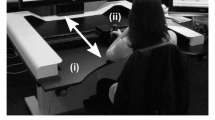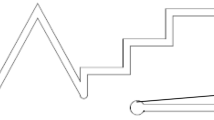Abstract
Aiming movements of the upper limbs can be classified either as discrete, or reciprocal, or cyclic. The control of these movements after a stroke can be affected. The aim of this experimental, cross-sectional study was to characterize the performance of these movements after the right and left hemisphere chronic stroke. Thirty-six individuals aged between 40 and 70 years, right-handed, were allocated into three groups (control, right stroke, and left stroke). Participants were asked to perform aiming movements on a tablet. Individuals after stroke performed the tasks only with their ipsilesional limb, while the control group performed movements with both limbs. The reaction and movement times, peak velocity, and the variability and error of the endpoint were analyzed. Individuals after stroke presented a worse performance in all movement classes as expected, but differently depending on the damaged hemisphere. Participants with right hemisphere damage showed larger endpoint errors, while those with left hemisphere damage had longer reaction and movement times. Both differences were seen consistently in discrete and reciprocal, but not in cyclic movements. Cyclic movements presented shorter latencies, were faster, and showed greater endpoint errors when compared to discrete and reciprocal movements. These results suggest that stroke affects differently the performance of discrete and reciprocal movements according to the hemisphere lesion side, but not in cyclic movements. Different levels of motor control among the three classes of movements by the nervous system may justify these results.



Similar content being viewed by others
References
Alouche SR, Sant'Anna GN, Biagioni G, Ribeiro-do-Valle LE (2012) Influence of cueing on the preparation and execution of untrained and trained complex motor responses. Braz J Med Biol Res 45(5):425–435
Brucki SMD, Nitrini R, Caramelli P, Bertolucci PHF, Okamoto IH (2003) Sugestões para o uso do mine-exame do estado mental no Brasil. Arq Neuropsiquiatria 61(3B):777–781
Calautti C, Baron JC (2003) Functional neuroimaging studies of motor recovery after stroke in adults: a review. Stroke 34(6):1553–1566
Carlson RG, Chua R, Goodman D, Byblow WD, Elliot D (1995) The preparation of aiming movements. Brain Cogn 28(2):133–154
Christe B, Burkhard PR, Pegna AJ, Mayer E, Hauert CA (2007) Clinical assessment of motor function: a processes oriented instrument based on a speed-accuracy trade-off paradigm. Behav Neurol 18(1):19–29
Delrio EG (1984) Óptica fisiológica clínica e refração. Toray, Barcelona
Dounskaia N (2010) Control of human limb movements: the leading joint hypothesis and its practical applications. Exerc Sport Sci Rev 38(4):201–208
Dounskaia N, Ketcham CJ, Stelmach GE (2002) Commonalities and differences in control of various drawing movements. Exp Brain Res 146(1):11–25
Dounskaia N, Wisleder D, Johnson T (2005) Influence of biomechanical factors on substructure of pointing movements. Exp Brain Res 164(4):505–516
Fang Y, Yue GH, Hrovat K, Sahgal V, Daly JJ (2007) Abnormal cognitive planning and movement smoothness control for a complex shoulder/elbow motor task in stroke survivors. J Neurol Sci 256(1–2):21–29
Freitas SM, Scholz JP (2009) Does hand dominance affect the use of motor abundance when reaching to uncertain targets? Hum Mov Sci 28(2):169–190
Galloway JC, Koshland GF (2002) General coordination of shoulder, elbow and wrist dynamics during multijoint arm movements. Exp Brain Res 142:163–180
Hogan N, Sternad D (2007) On rhythmic and discrete movements: reflections, definitions and implications for motor control. Exp Brain Res 181(1):13–30
Hsieh T-Y, Liu Y-T, Newell KM (2017) Submovement control processes in discrete aiming as a function of space-time constraints. PLoS ONE 12(12):e0189328
Kandel E, Schwartz J, Jessel T, Siegelbaum S, Hudspeth A (2012) Principles of neuroscience, 5th edn. McGraw-Hill, New York
Lajoie JM, Franks IM (1997) Response programming as a function of accuracy and complexity: evidence from latency and kinematic measures. Hum Mov Sci 16:485–505
MacKay-Lyons M (2002) Central pattern generation of locomotion: a review of the evidence. Phys Ther 82(1):69–83
Maki T, Quagliato EMAB, Cacho EWA, Paz LPS, Nascimento NH, Inoue MMEA, Viana MA (2006) Estudo de confiabilidade da aplicação da escala de Fugl-Meyer no Brasil. Revista Brasileira de Fisioterapia 10(2):177–183
Marder E, Bucher D (2001) Central pattern generators and the control of rhythmic movements. Curr Biol 11(23):986–996
Oldfield RC (1971) The assessment and analysis of handedness: the Edinburgh Inventory. Neuropsychololgia 9:97–113
Paiva Silva FP, Freitas S, Banjai RM, Alouche SR (2017) Ipsilesional arm aiming movements after stroke: influence of the degree of contralesional impairment. J Mot Behav 30(11):1–12
Paiva Silva FP, Freitas SM, Silva PV, Banjai RM, Alouche SR (2014) Ipsilesional arm motor sequence performance after right and left hemisphere damage. J Motor Behav 46(6):407–414
Ribeiro Coqueiro P, de Freitas SM, Assunção e Silva CM, Alouche SR (2014) Effects of direction and index of difficulty on aiming movements after stroke. Behav Neurol 2014:909182
Sainburg RL (2002) Evidence for a dynamic-dominance hypothesis of handedness. Exp Brain Res 142(2):241–258
Sainburg RL, Duff SV (2006) Does motor lateralization have implications for stroke rehabilitation? J Rehabil Res Dev 43(3):311–322
Sainburg RL, Schaefer SY (2004) Interlimb differences in control of movement extent. J Neurophysiol 92(3):1374–1383
Schaal S, Sternad D, Osu R, Kawato M (2004) Rhythmic arm movement is not discrete. Nat Neurosci 7(10):1136–1143
Schaefer SY, Haaland KY, Sainburg RL (2007) Ipsilesional motor deficits following stroke reflect hemispheric specializations for movement control. Brain 130:2146–2158
Smits-Engelsman BCM, Van Galen GP, Duysens J (2002) The breakdown of Fitt’s law in rapid, reciprocal aiming movements. Exp Brain Res 145:222–230
Smits-Engelsman BC, Sugden D, Duysens J (2006b) Developmental trends in speed-accuracy trade-off in 6–10-year-old children performing rapid reciprocal and discrete aiming movements. Hum Mov Sci 25(1):37–49
Smits-Engelsman BCM, Swinnen SP, Duysens J (2006a) The advantage of cyclic over discrete movements remains evident following changes in load and amplitude. Neurosci Lett 396(1):28–32
Wang W, Johnson J, Sainburg RL, Dounskaia NV (2012) Interlimb differences of directional biases for stroke production. Exp Brain Res 216(2):263–274
Winstein CJ, Pohl PS (1995) Effects of unilateral brain damage on the control of goal-directed hand movements. Exp Brain Res 105:163–174
Author information
Authors and Affiliations
Corresponding author
Additional information
Communicated by Winston D Byblow.
Publisher's Note
Springer Nature remains neutral with regard to jurisdictional claims in published maps and institutional affiliations.
Rights and permissions
About this article
Cite this article
Carvalho, D.B., Freitas, S.M.S.F., Alencar, F.A.D. et al. Performance of discrete, reciprocal, and cyclic movements of the ipsilesional upper limb in individuals after stroke. Exp Brain Res 238, 2323–2331 (2020). https://doi.org/10.1007/s00221-020-05897-6
Received:
Accepted:
Published:
Issue Date:
DOI: https://doi.org/10.1007/s00221-020-05897-6




